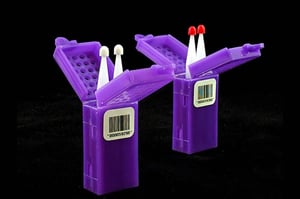Share this
what is microsampling? a look at the bigger picture
by Neoteryx Microsampling on Jun 1, 2018 4:41:00 AM
/Hands_Mitra%20Microsampling.png?width=414&height=189&name=Hands_Mitra%20Microsampling.png) As our international and interpersonal networks grow larger and stronger, a little information can go a long way. Our world is getting smaller. Our technology is getting smaller, too. And it's getting a lot more powerful.
As our international and interpersonal networks grow larger and stronger, a little information can go a long way. Our world is getting smaller. Our technology is getting smaller, too. And it's getting a lot more powerful.
For centuries, collecting blood specimens has been difficult, and painful. Yet, it is an essential part of the process for scientific research, developing new drugs, and treating patients effectively.
Advances in science and research have changed the landscape of healthcare. One tiny drop of blood (or other biological fluid) can yield enormous amounts of useful data. As little as 10 microliters of blood can generate results on par with those that traditionally would have required much larger blood draws.
However, problems remain at the blood sampling event itself. Wet blood collection requires cold chain shipping and biohazard storage. Venipuncture requires special skills to perform, and remains scary and painful for patients. Older dried blood collection methods have been difficult to implement at scale. There has been no good way to collect these small volumes of dried blood. Until now.
At Neoteryx, we deliver on the promise and the process of microsampling. How do we do it? We’ve made possible a new and different sort of sampling event. We develop, manufacture, and distribute a small, absurdly simple, remarkably powerful new medical device.

This is the Mitra® Microsampling Device, based on Volumetric Absorptive Microsampling (VAMS™) technology. It's the first instrument designed to collect quantitative, volumetrically accurate samples of dried blood and other biological fluids. It's available in patient-centered and lab-centered formats, and it's easily amenable to downstream extraction automation. With our array of automation solutions, larger labs can process hundreds or thousands of samples per day.
The action happens in the tip, which collects specimens as small as five to 30 microliters. In this tiny sampling event, we see the potential to save lives, transform healthcare, and open new frontiers for medicine and research - figuratively and literally.
The Mitra Microsampling device can be used to collect accurate samples anywhere, at any time, by almost anyone. It has applications in the pharmaceuticals, clinical trials, clinical testing and research, preclinical research, health and wellness, and beyond.
Microsampling matters because it allows for Remote Sampling.
Remote Sampling takes blood collection out of the clinic. This creates a more patient-centered lab experience, and it helps patients stay closer to their families, their communities, and all the things that help them stay healthy and whole. And Remote Sampling has taken blood collection to some remarkable places.
If it can work for measuring biomarkers in Liberia, imagine what it can do in your lab.
At Neoteryx, we may sample small, but we're thinking big. At the tip of this small device, we've discovered the potential to improve patient experience and clinical results around the world. We’re involved with groundbreaking projects at the Advanced Clinical Biosystems Research Institute at Cedars-Sinai, the Mayo Clinic, UCB, Nazionale Neurologico Carlo Besta, and many more.
And we're just getting started. From the results we're getting from this breakthrough, we're developing a whole new range of solutions for labs of all shapes, sizes, and levels of throughput.
Small samples are having a big impact. When you take blood collection out of the clinic - and connect the most powerful ideas in healthtech, precision medicine, and patient-centered care with the stuff of human life - you can change the world.

Share this
- Microsampling (206)
- Research, Remote Research (119)
- Venipuncture Alternative (105)
- Clinical Trials, Clinical Research (83)
- Mitra® Device (73)
- Therapeutic Drug Monitoring, TDM (51)
- Dried Blood Spot, DBS (39)
- Biomonitoring, Health, Wellness (30)
- Infectious Disease, Vaccines, COVID-19 (24)
- Blood Microsampling, Serology (23)
- Omics, Multi-Omics (21)
- Decentralized Clinical Trial (DCT) (20)
- Specimen Collection (18)
- Toxicology, Doping, Drug/Alcohol Monitoring, PEth (17)
- Skin Microsampling, Microbiopsy (14)
- hemaPEN® Device (13)
- Preclinical Research, Animal Studies (12)
- Pharmaceuticals, Drug Development (9)
- Harpera Device (7)
- Industry News, Microsampling News (5)
- Antibodies, MAbs (3)
- Company Press Release, Product Press Release (3)
- Environmental Toxins, Exposures (1)
- July 2025 (1)
- May 2025 (1)
- April 2025 (2)
- December 2024 (2)
- November 2024 (1)
- October 2024 (3)
- September 2024 (1)
- June 2024 (1)
- May 2024 (1)
- April 2024 (4)
- March 2024 (1)
- February 2024 (2)
- January 2024 (4)
- December 2023 (3)
- November 2023 (3)
- October 2023 (3)
- September 2023 (3)
- July 2023 (3)
- June 2023 (2)
- April 2023 (2)
- March 2023 (2)
- February 2023 (2)
- January 2023 (3)
- December 2022 (2)
- November 2022 (3)
- October 2022 (4)
- September 2022 (3)
- August 2022 (5)
- July 2022 (2)
- June 2022 (2)
- May 2022 (4)
- April 2022 (3)
- March 2022 (3)
- February 2022 (4)
- January 2022 (5)
- December 2021 (3)
- November 2021 (5)
- October 2021 (3)
- September 2021 (3)
- August 2021 (4)
- July 2021 (4)
- June 2021 (4)
- May 2021 (4)
- April 2021 (3)
- March 2021 (5)
- February 2021 (4)
- January 2021 (4)
- December 2020 (3)
- November 2020 (5)
- October 2020 (4)
- September 2020 (3)
- August 2020 (3)
- July 2020 (6)
- June 2020 (4)
- May 2020 (4)
- April 2020 (3)
- March 2020 (6)
- February 2020 (3)
- January 2020 (4)
- December 2019 (5)
- November 2019 (4)
- October 2019 (2)
- September 2019 (4)
- August 2019 (4)
- July 2019 (3)
- June 2019 (7)
- May 2019 (6)
- April 2019 (5)
- March 2019 (6)
- February 2019 (5)
- January 2019 (8)
- December 2018 (3)
- November 2018 (4)
- October 2018 (7)
- September 2018 (6)
- August 2018 (5)
- July 2018 (8)
- June 2018 (6)
- May 2018 (5)
- April 2018 (6)
- March 2018 (4)
- February 2018 (6)
- January 2018 (4)
- December 2017 (2)
- November 2017 (3)
- October 2017 (2)
- September 2017 (4)
- August 2017 (2)
- July 2017 (4)
- June 2017 (5)
- May 2017 (6)
- April 2017 (6)
- March 2017 (5)
- February 2017 (4)
- January 2017 (1)
- July 2016 (3)
- May 2016 (1)
- April 2016 (2)


Comments (1)